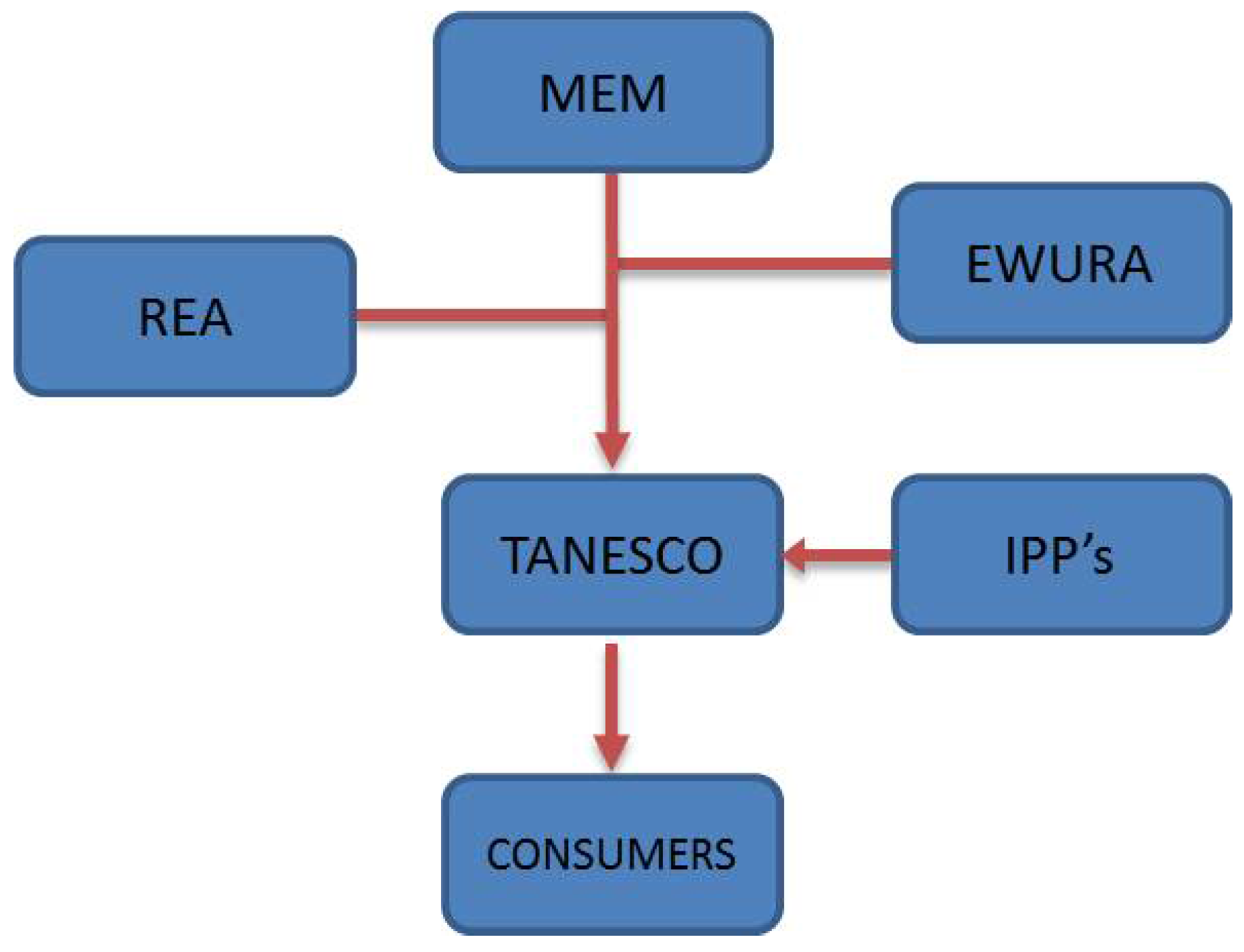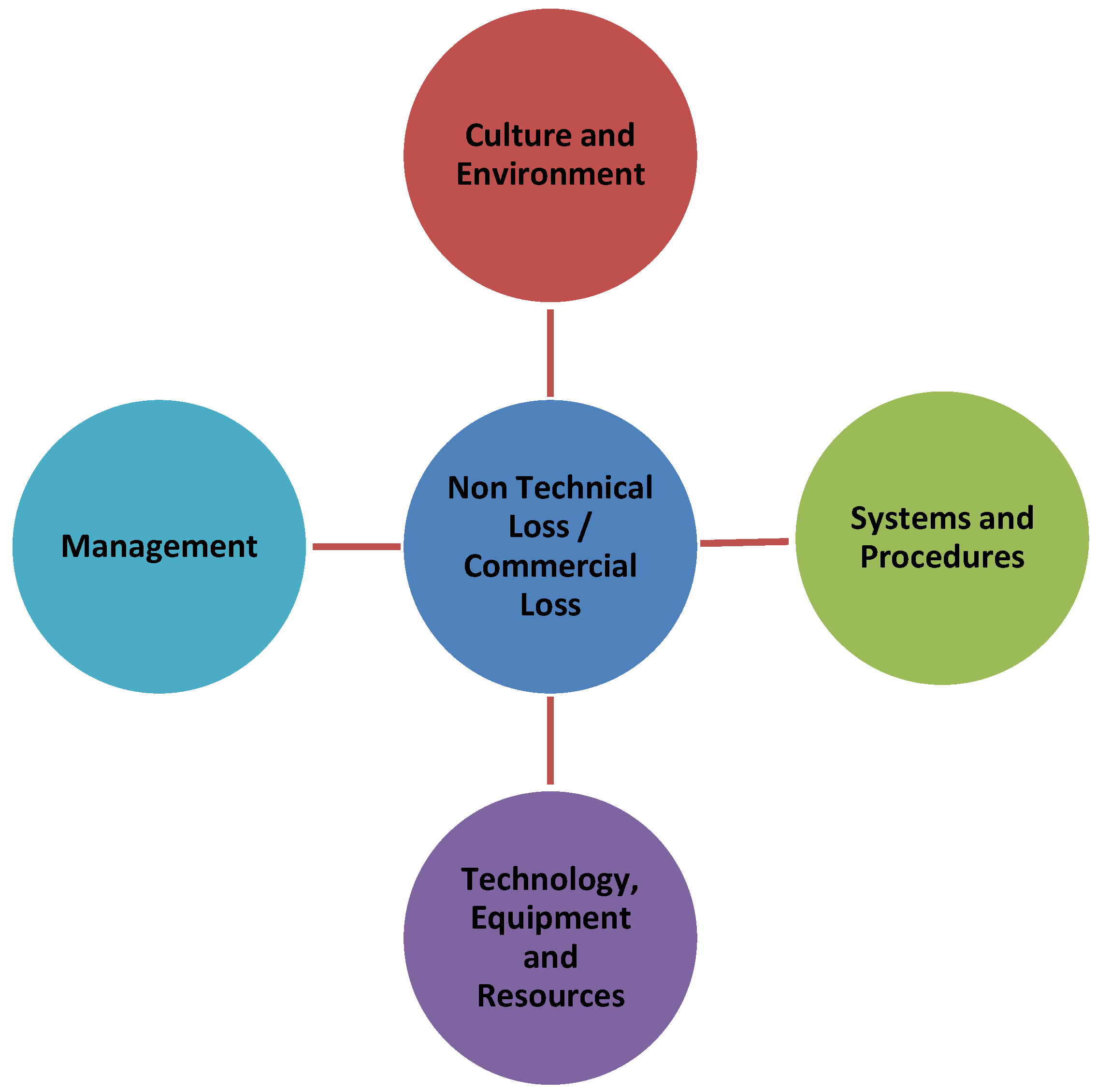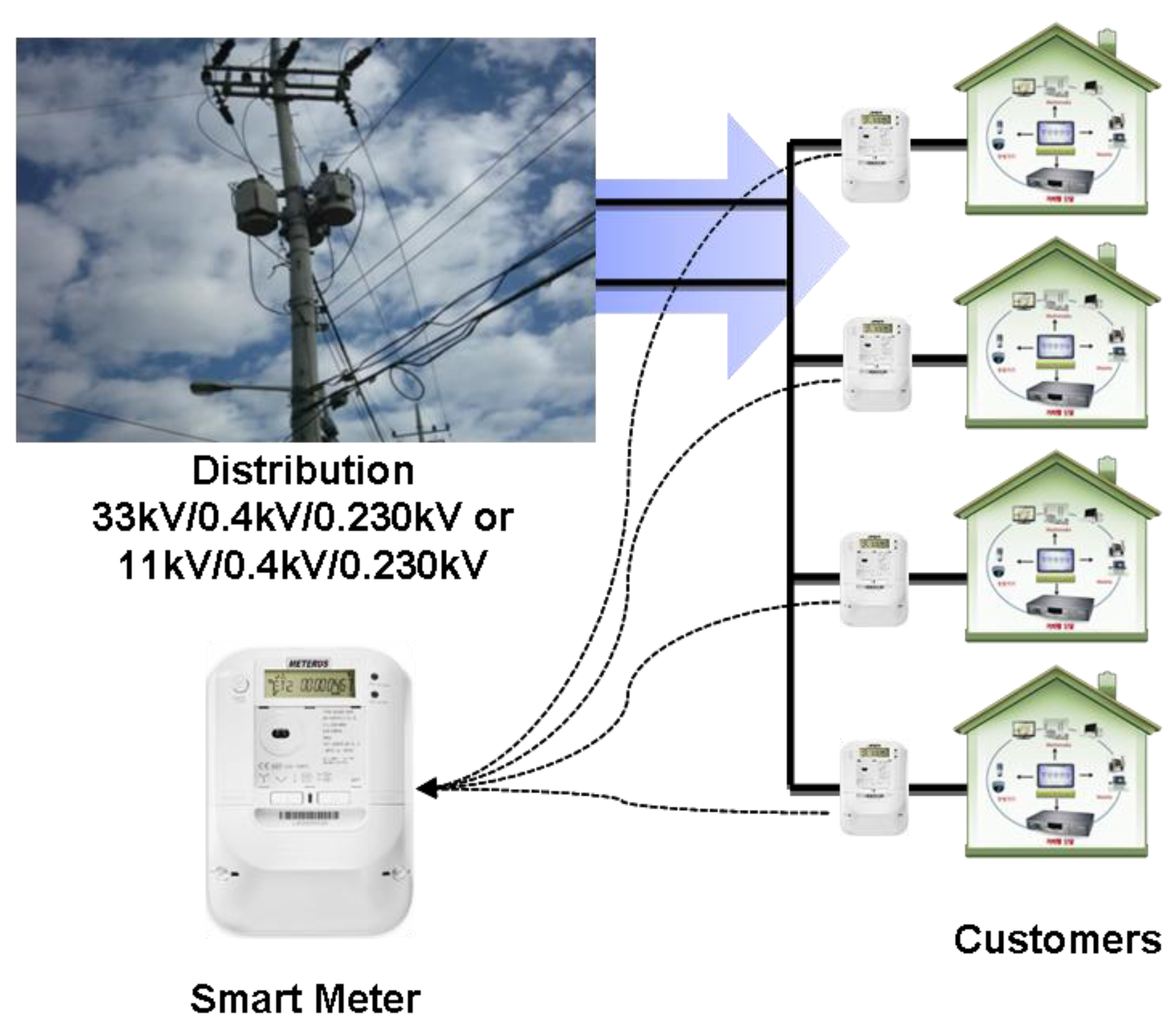Visions, Scenarios and Action Plans Towards Next Generation Tanzania Power System
Abstract
:1. Introduction

2. Tanzania Electricity Industry Structure

2.1. Regulatory Arrangements
2.2. Setting of Electricity Prices
| Tariff categories | Description | Notes |
|---|---|---|
| D1 | This category covers domestic customers who on average have a consumption pattern for 50 kWh. The 50 kwh are subsidized by company and not subject to service charge. Under the category, any unit exceeding 50 kWh is charged a higher rate up to 283.4 kWh | Domestic low usage tariff (1-phase 230 V) |
| T1 | This segment is applicable for customers who use power for general purposes, including residential, small commercial and light industrial use, public lighting, and billboards. In this category the average consumption is more than 283.4 kWh per meter reading period | General usage tariff (1-phase 230 V or 3-phase 400 V) |
| T2 | Industrial consumers with monthly consumption greater than 7500 kWh and demand less than 500 kVA | Low voltage maximum demand (MD) usage tariff (supplied at 400 V) |
| T3 | Industrial consumers | High voltage maximum demand (MD) usage tariff (11 kV and above) |
| Description categories | D1 | T1 | T2 | T3 |
|---|---|---|---|---|
| Low energy (0–50 kWh)—per kWh | 153.00 | |||
| High energy charge per kWh (above 50 kWh) | 497.00 | |||
| Service charge per month | 3841.00 | 25,875.00 | 25,875.00 | |
| Demand charge per KVA | 30,802.00 | 26,395.00 | ||
| Energy charge per kWh | 400.00 | 240.00 | 212.00 |
3. Current Challenges in the Existing Power Systems
3.1. Generation
| Plant | Generation type/ownership | Installed capacity (MW) | Available capacity (MW) |
|---|---|---|---|
| Kidatu | Hydro/own | 204 | 200 * |
| Kihansi | Hydro/own | 180 | 180 * |
| Mtera | Hydro/own | 80 | 80 * |
| Newpanganifalls | Hydro/own | 68 | 66 * |
| Hale | Hydro/own | 21 | 17 * |
| Nyumbayamungu | Hydro/own | 8 | 8 * |
| Uwemba | Hydro/own | 1 | 1 |
| Songas | Gas/IPP | 202 | 185 |
| Ubungo wartsila | Gas/own | 102 | 100 |
| Tegeta wartsila | Gas/own | 45 | 42 |
| Tegeta IPTL | HFO/IPP | 103 | 100 |
| Symbion | IDO/IPP | 115 | 103 |
| Total hydro | 562 | 552 | |
| Total thermal | 567 | 530 | |
| Grand total | 1129 | 1082 |
| Name of plant | Number of unit | Max available capacity (MW) | Source of energy | Commissioned year |
|---|---|---|---|---|
| Tunduru | 4 | 1.000 | IDO/Gas oil | 1992 & 2008 |
| Kigoma | 14 | 9.200 | IDO/Gas oil | 1981–2010 |
| Ngara | 2 | 0.560 | IDO/Gas oil | 1991 |
| Mpanda | 4 | 1.840 | IDO/Gas oil | 1993 |
| Mbinga | 3 | 0.830 | IDO/Gas oil | 2000 & 2008 |
| Somanga | 3 | 5.000 | Natural Gas | 2010 |
| Songea | 6 | 3.150 | IDO/Gas oil | 1987/88, 2004/09 |
| Liwale | 3 | 0.287 | Gas oil | 2002/2003/2006 |
| Mafia | 2 | 0.424 | IDO/Gas oil | 1990 & 1991 |
| Biharamulo | 2 | 0.460 | IDO/Gas oil | 1991 |
| Kilwa Masoko | 2 | 0.750 | Gas | 1977 & 1999 |
| Masasi | 3 | 3.800 | IDO | 1985 |
| Ikwiriri | 2 | 0.436 | Gas | 1991 |
| Kasulu | 2 | 2.500 | IDO | 2011 |
| Kibondo | 2 | 2.500 | IDO | 2011 |
| Mtwara | 9 | 10.000 | Natural Gas | 2007 |
| Ludewa | 3 | 0.760 | IDO | 2008 |
| Total | 66 | 21.630 |
3.2. Financial Aspects
3.2.1. High Transmission and Distribution Losses
3.2.2. Revenue Loss
3.2.3. High Tariff
3.2.4. Aging Infrastructure
3.3. Load Growth Outstripping Supply
| Year | Demand forecast (MW) | Year | Demand forecast (MW) |
|---|---|---|---|
| 2012 | 1031 | 2019 | 2055 |
| 2013 | 1210 | 2020 | 2202 |
| 2014 | 1333 | 2021 | 2361 |
| 2015 | 1471 | 2022 | 2536 |
| 2016 | 1593 | 2023 | 2740 |
| 2017 | 1778 | 2024 | 2951 |
| 2018 | 1925 | 2025 | 3177 |
3.4. Environmental Impact
3.5. Interconnection with Neighboring Countries
4. Why Smart Grid in Tanzania
- allow for the integration of renewable energy resources to address global climate change;
- allow for better utilization of existing assets to address long term sustainability;
- allow for optimized energy flow to reduce losses and lower the cost of energy;
- allow for the management of distributed generation and energy storage to eliminate or defer system expansion and reduce the overall cost of energy;
- allow for the integration of communication and control across the energy system to promote interoperability and open systems and to increase safety and operational flexibility;
- allow for active customer participation to enable far better energy conservation.
5. Current Initiatives toward a Stronger, More Secure and More Efficient Smart Grid
| Year commissioned | Name of the project | Type | Additional capacity (MW) |
|---|---|---|---|
| 2012 | Ubungo Plant | Gas | 100 |
| 2012 | Mwanza | HFO | 60 |
| 2013 | Singida Wind Farm | Wind | 100 |
| 2013 | Kinyerezi CC | Gas | 240 |
| 2013 | Kiwira I | Coal | 200 |
| 2013 | Mnazi Bay Mtwara CC | Gas | 300 |
| 2013 | Somanga Fungu | Gas | 230 |
| Year | Name of project | Type | Additional capacity | Total installed capacity (MW) | Project demand (MW) | Project power pool (MW) |
|---|---|---|---|---|---|---|
| 2015 | Rusumo Falls | Hydro | 21 | 1682 | 1471 | 211 |
| 2015 | Interconnector I (Singida-Nairobi) | Import/Export | 200 | |||
| 2016 | Ruhudji Hydro Project | Hydro | 358 | 2048 | 1593 | 455 |
| 2018 | Rumakali Project | Hydro | 222 | 2582 | 1925 | 657 |
| 2020 | Stieglers Gorge I | Hydro | 300 | 2882 | 2202 | 680 |
| 2021 | Interconnector II (Zambia-Tanzania) | Import/Export | 200 | 3082 | 2361 | 721 |
| 2023 | Stieglers Gorge II | Hydro | 600 | 3542 | 2740 | 802 |
| 2024 | Ngaka Coal Project | Coal | 400 | 3755 | 2951 | 804 |
| 2025 | Mchuchuma I&II | Coal | 400 | 4155 | 3177 | 978 |
| 2026 | Stieglers Gorge III | Hydro | 300 | 4455 | 3437 | 1018 |
5.1. Energy Balance Mix
| Resource | Potential | Power | Degree of exploitation |
|---|---|---|---|
| Hydro | 4700 MW | 4700 MW | 562 MW |
| Biomass | Sustained yield 24.3 million m3 p.a | 26 MW | Use 40 million m3 91,276 hectare p.a. deforestation |
| Coal | 304 million tons | 1600 MW | 3 MW |
| Natural Gas | 64 billion m3 | 500 MW | 361 MW |
| Wind | Speed: 7.6–9.9 m/s | 200 MW | Not exploited |
| Solar | 187 W/mm2 | Approximately 215 W/m2/day | 2 MW |
| Geo-Thermal | 650 MW | 650 MW | Not exploited |
| Uranium | Not assessed | Not exploited | |
| Tidal&Wave | Not assessed | Not exploited |
5.1.1. Mchuchuma Coal power
5.1.2. Renewable Energy
5.1.3. Existing Hydro and Thermal Power
| Category | Description |
|---|---|
| Variable | Generation from wind and sun, which can vary with time. |
| Non-Variable | Generation from continuous process, coal, water and biomass. |
| Renewable | Generation from a source that can be replenished, e.g., wind, water, biomass. |
| Non-Renewable | Generation from a source that cannot be replenished, e.g., coal or oil. |

5.2. Transmission Systems
| Grid Transmission system additions | Year | Distance (km) |
|---|---|---|
| 132 kV Ubungo-Mtoni (Zanzibar) | 2012 | 46 |
| 132 kV Makambako-Songea | 2013 | 320 |
| 300 kV Mnazi Bay-Singida(DC Line) | 2013 | 1,000 |
| 400 kV Iringa-Shinyanga | 2013 | 647 |
| 220 kV Kiwira-Mbeya | 2013 | 100 |
| 220 kV Kinyerezi-Ubungo | 2013 | 15 |
| 400 kV Morogoro-Chalinze-Arusha | 2013 | 602 |
| 400 kV Singida-Arusha-Nairobi | 2014 | 320 |
| 400 kV Kasama-Mbeya-Iringa | 2015 | 540 |
| 400 kV Shinyanga-Mwanza | 2015 | 140 |
| 220 kV Bulyanhulu-Geita | 2013 | 100 |
| 220 kV Geita-Nyakanazi-Rusumo | 2015 | 228 |
| 220 kV Ruhudji-Mufindi | 2017 | 200 |
| 220 kV Ruhudji-Kihansi | 2017 | 150 |
| 220 kV Rumakali-Makambako | 2018 | 200 |



5.3. Distribution Systems

5.4. Loss Reduction Program
5.4.1. Technical Loss
| Energy losses | 2008 | 2009 | 2010 | 2011 | 2012 | 2013 | 2014 |
|---|---|---|---|---|---|---|---|
| Distribution losses (%Energy Fed into MV Network) | 18.0% | 19.7% | 19.7% | 18.5% | 17.2% | 15.9% | 14.6% |
| Transmission Losses (% of Generation) | 5.1% | 5.3% | 5.3% | 5.2% | 5.1% | 5.0% | 4.4% |
5.4.2. Non-Technical Loss and Commercial Loss

- Culture and Environment
- Over a period, implement a staff awareness program combined with sanctions to combat the culture of corruption and collusion.
- Implement a public awareness campaign to advise customers of the implications of electricity theft and to encourage “whistle blowers” to provide information.
- Commence moves to have the legal powers strengthened to help secure convictions for electricity theft.
- Systems and Procedures
- Produce a comprehensive policy document on revenue protection to be communicated to all.
- Ensure that payment channels are adequate to encourage convenient purchase of credit or payment of bills.
- Develop a system of focused visits to premises where theft may be suspected.
- Utilize meter readers to a much greater degree to report suspicious installations.
- Technology, Equipment and Resources
- Provide proper resourcing for revenue protection units, including personnel and Transport.
- Consider the use of portable meter-testing equipment for on-site testing.
- Pilot an extension of the split-meter concept (currently under consideration for AMR customers) to specific non-AMR customers.
- Management
- Undertake proper planning of revenue protection activity with short-term, medium-term and longer-term plans prepared at the appropriate levels.
- Provide ethics and management development training for Revenue Protection Managers and for Zonal Managers in the future.
- Ensure security or provide incentives to both staff and “whistle blowers”.
5.5. Revenue Collection
5.6. Rural Electrification Policy
5.7. Customer
| Years | 2009 | 2010 | 2011 | 2012 | 2013 | 2014 |
|---|---|---|---|---|---|---|
| Customer Growth Rates per Annum | 12.1% | 16.9% | 10.8% | 9.7% | 10.5% | 12.7% |

5.8. Environmental Protection
6. Discussion
- Energy balance mix—the future security of electricity supply will be ensured.
- Smart transmission lines—the future transmission losses will be reduced, transmission capacity will be maximized and reliability and quality of grid power will be significantly improved.
- Smart distribution lines—the modern distribution system will be able to distribute the electricity to and from the end customers in a smart way, where distribution network connects the smart meters and all intelligent field devices and manage and control them through a two-way wireless or wired communication network. It may also connect to energy storage facilities and alternative distributed energy resources at the distribution level.
- Loss reduction program—the occurrence of load-shedding will be reduced. This will increase the revenue collections and the financial position to TANESCO.
- Revenue collection increases—this will allow TANESCO to improve its financial position, and therefore develop a system with an adequate reserve capacity margin that can support the development of future Tanzania power system in the most effective, competitive and sustainable manner.
- Rural electrification policy—there will be improved energy supply in the rural areas through public and private sector participation, which will contribute significantly in the livelihoods of the rural population and the attainment of sustainable economic growth.
- Behavioral changes in electricity consumption—customers will be more proactive and empowered to engage in energy consumption decisions affecting their day-to-day lives.
- Smart meters technology—the metering efficiency will be improved to enable proper energy accounting, improved billing systems and collections.
- Environmental protections—the deforestation due to excessive use of fire-wood and charcoal will be curbed and the carbon emissions will be reduced, which is the urgent global priority.
- Integrated approach (individual issues program)—the challenges that TANESCO faces in terms of non-technical loss (theft, corruptions, sabotages) will be addressed.
7. Conclusions
- The Tanzania government should form an inter-ministerial committee to deal with integrated water resource management as a means of managing water crises in power generating dams.
- The Tanzanian government should invest more resources towards identifying sources of energy and encourage private investors to develop them for use.
- The Tanzania government should encourage and facilitate research in technologies aimed at promoting the power sector. In this respect R&D institutions, as a matter of priority, should be engaged in research to assist Tanzania in its efforts to diversify energy sources.
- The Ministry of Energy and Minerals in Tanzania should put in place a coordinating body to ensure efforts towards smart electric grid technology.
- Professional bodies in Tanzania should be involved in brainstorming on the power situation in Tanzania toward suitable energy balance mix for sustainable social-economic development.
Acknowledgements
References
- TANESCO. Power System Master Plan Study; TANESCO: Dar es Salaam, Tanzania, 2009; Volume I–III. [Google Scholar]
- Mgonja, S. Electricity energy status in Tanzania. In Proceedings of the 9th Annual Engineers Day, Dar es Salaam, Tanzania, 1–2 September 2011.
- Mwasumbi, H.; Tzoneva, R. Power sector in Tanzania: Performance, trends and reforms. In Proceedings of 8th IEEE Africon, Windhoek, Namibia, 26–28 September 2007; pp. 1–7.
- Yu, Y.; Yang, J.; Chen, B. The smart grids in China: A review. Energies 2012, 5, 1321–1338. [Google Scholar] [CrossRef]
- TANESCO. Provision of Financial Advisory and Modeling Services to TANESCO; TANESCO: Dar es Salaam, Tanzania, 2010. [Google Scholar]
- TANESCO. An Application for Emergency Tariff; TANESCO: Dar es Salaam, Tanzania, 2011. [Google Scholar]
- Robert, V. Long Run Marginal Cost of Service, Tariff Study; Final Report to Tanzania Electric Supply Company: Dar es Salaam, Tanzania, 2010. [Google Scholar]
- Kihwele, S.; Kyaruzi, A. Effect of poor designing of distribution system case study Tanzania electric supply company network. In Proceedings of IEEE International Conference on Power System Technology, Dar es Salaam, Tanzania, 21–24 November 2004; Volume 2, pp. 1298–1302.
- Board, E.R. Energy crisis: Challenge for a focus and investment on alternative energy sources for Tanzania. In Proceedings of the 5th Annual Engineers Day, Dar es Salaam, Tanzania, 10 October 2007.
- Mwampamba, T. Has the woodfuel crisis returned? Urban charcoal consumption in Tanzania and its implications to present and future forest availability. Energy Policy 2007, 35, 4221–4234. [Google Scholar] [CrossRef]
- Hammons, T. Status of implementation of generation, transmission and interconnection projects in the Southern Africa Power Pool. In Proceedings of the 45th IEEE International Universities Power Engineering Conference (UPEC), Cardiff, Wales, 31 August–3 September 2010; pp. 1–9.
- Gharavi, H.; Ghafurian, R. Smart grid: The electric energy system of the future. Proc. IEEE 2011, 99, 917–921. [Google Scholar] [CrossRef]
- Kihwele, S.; Hur, K. Modeling and analysis of bipolar HVDC interlink for Tanzania power grid. In Proceedings of 2012 IEEE Power Engineering Society General Meeting, San Diego, CA, USA, 22–26 July 2012; pp. 1126–1130.
- TANESCO and ZECO. Electricity Loss Reduction Study; TANESCO and ZECO: Dar es Salaam, Tanzania, and Richmond, BC, Canada, 2011. [Google Scholar]
- Van den Broek, R.; Lemmens, L. Rural electrification in Tanzania: Constructive use of project appraisal. Energy Policy 1997, 25, 43–54. [Google Scholar]
- Arnold, G. Challenges and opportunities in smart grid: A position article. Proc. IEEE 2011, 99, 922–927. [Google Scholar]
- Depuru, S.; Wang, L.; Devabhaktuni, V. Smart meters for power grid: Challenges, issues, advantages and status. Renew. Sustain. Energy Rev. 2011, 15, 2736–2742. [Google Scholar]
© 2012 by the authors; licensee MDPI, Basel, Switzerland. This article is an open access article distributed under the terms and conditions of the Creative Commons Attribution license (http://creativecommons.org/licenses/by/3.0/).
Share and Cite
Kihwele, S.; Hur, K.; Kyaruzi, A. Visions, Scenarios and Action Plans Towards Next Generation Tanzania Power System. Energies 2012, 5, 3908-3927. https://doi.org/10.3390/en5103908
Kihwele S, Hur K, Kyaruzi A. Visions, Scenarios and Action Plans Towards Next Generation Tanzania Power System. Energies. 2012; 5(10):3908-3927. https://doi.org/10.3390/en5103908
Chicago/Turabian StyleKihwele, Santos, Kyeon Hur, and Alex Kyaruzi. 2012. "Visions, Scenarios and Action Plans Towards Next Generation Tanzania Power System" Energies 5, no. 10: 3908-3927. https://doi.org/10.3390/en5103908






